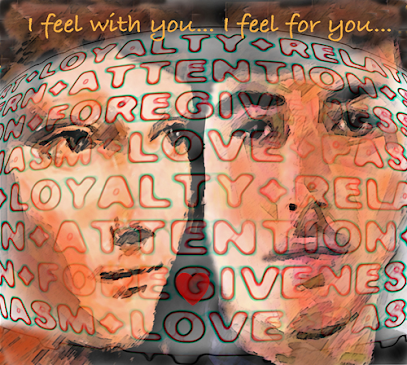Life, Literature & Beyond
Of love, Shakespeare and multifaceted influences on human life
Love's epistemological foundations emerge from primordial mythopoeic consciousness, wherein Eros functions as a liminal deity embodying the dialectical tension between creation and annihilation. The Orphic descent narrative constitutes a paradigmatic katabasis, elucidating love's capacity for ontological transgression and its inherent susceptibility to thanatological inevitability. Aristotelian tripartite taxonomies—eros (libidinal cathexis), philia (reciprocal alterity), and agape (self-abnegating transcendence)—establish a hierarchical valorization wherein virtue-based intersubjectivity achieves eudaimonic actualization through contemplative praxis and ethical reciprocity, thereby facilitating both individual entelechy and collective apokatastasis.
Shakespeare's dramaturgical corpus manifests as a palimpsestic exploration of love's heterogeneous manifestations, oscillating between neoplatonic idealization and materialist disillusionment. In "Romeo and Juliet," erotic passion functions as a transgressive force undermining patriarchal hegemony through performative contradiction, while Juliet's metaphysical apostrophe regarding love's infinitude simultaneously reifies romantic transcendentalism and exposes its epistemic contradictions within feudal sociocultural matrices. "A Midsummer Night's Dream" employs carnivalesque inversion to deconstruct romantic essentialism, while "Othello" excavates love's psychopathological substrate through paranoid projection and racialized alterity. Sonnet 116 articulates love's ontological permanence through negative theology, juxtaposing temporal contingency with affective immutability.
Eastern narrative paradigms—particularly the Persian ghazal tradition embodied in Laili-Majnu and Bengali Mangalkavya exemplified by Behula-Lokhindar—conceptualize love through theophanic revelation and cosmological resistance. Behula's perilous navigation through divine machinations constitutes a feminine rewriting of heroic monomyth, wherein devotional steadfastness achieves soteriological efficacy through sustained theophanic communion. The Laili-Majnu topos epitomizes mystical fana, wherein erotic longing becomes vehicular for spiritual annihilation and divine union, embodying the Sufi paradox of self-obliteration as ultimate realization. These narratives employ typological symbolism to interrogate the boundaries between sacred and profane desire.
Tagore's metaphysical romanticism in "Ananta Prem" articulates love through trans migrative continuity and karmic inevitability: "I seem to have loved you in numberless forms, numberless times, In life after life, in age after age, forever." This formulation synthesizes Upanishadic eternalism with Victorian sentimentality, positioning romantic attachment as participatory mysticism transcending spatiotemporal limitations. Conversely, Jibanananda Das's symbolist aesthetics in "Banalata Sen" deploys archaeological metaphors and civilizational decay to articulate love's melancholic temporality: his protagonist's millennial peregrination through historical sedimentations culminates in momentary epiphanic stasis, suggesting love's function as existential palliative amid cosmic entropy and cultural dissolution.
Platonic erotic, systematized through dialectical ascension in "The Symposium," posits love as anamnestic recovery of primordial unity through progressive abstraction from sensuous particularity toward noetic universality. Schopenhauer's pessimistic voluntarism reconceptualizes love as illusory compensation for metaphysical suffering, wherein biological imperatives masquerade as transcendent purpose while perpetuating existential futility. Contemporary psychoanalytical discourse, from Lacanian structural linguistics to Kristevian abject materialism, deconstructs romantic ideology as symptomatic of unconscious lack and symbolic alienation, thereby revealing love's function as simultaneously constitutive and destructive of subjectivity itself.
Here are 10 extremely challenging vocabulary words from the passage with their precise meanings:
1. Phenomenological
Meaning: Relating to phenomenology—the philosophical study of consciousness, experience, and the structures of experience as experienced from the first-person point of view.
2. Katabasis
Meaning: A descent into the underworld or netherworld; in literature, a journey to hell or the land of the dead (from Greek mythology and epic literature).
3. Eudaimonic
Meaning: Relating to eudaimonia—Aristotelian concept of human flourishing, well-being, or living well through virtue and excellence of character.
4. Entelechy
Meaning: The realization of potential; in Aristotelian philosophy, the condition of something whose essence is fully realized or actualized.
5. Apokatastasis
Meaning: The restoration of all things to their original or perfect state; in theology, the universal reconciliation or restoration of all creation.
6. Palimpsestic
Meaning: Resembling a palimpsest—a manuscript page from which text has been scraped off so it can be reused, but traces of the original remain visible; metaphorically, having multiple layers of meaning.
7. Theophanic
Meaning: Relating to theophany—a manifestation or appearance of a deity to humans; divine revelation or showing.
8. Soteriological
Meaning: Relating to soteriology—the theological doctrine of salvation, especially concerning the saving of the soul from sin and its consequences.
9. Anamnestic
Meaning: Relating to anamnesis—recollection or reminiscence; in Platonic philosophy, the theory that learning is actually remembering knowledge from past lives.
10. Noetic
Meaning: Relating to the mind, intellect, or reasoning; pertaining to purely intellectual apprehension or the realm of thought and knowledge.
Love Through History: A Simple Summary
This passage explores how different cultures and thinkers have understood love throughout history.
Ancient Times: The Greeks saw love as powerful but unpredictable, like their god Eros. The philosopher Aristotle identified three types of love: romantic passion, friendship, and selfless care for others. He believed the best love was based on respect and virtue.
Shakespeare's View: Shakespeare showed love's many faces in his plays and poems. In "Romeo and Juliet," love transforms people and makes them brave enough to challenge society. In "A Midsummer Night's Dream," he showed love as silly and changeable. In "Othello," he revealed how love can become dangerous through jealousy. Overall, Shakespeare believed true love lasts forever.
Eastern Stories: Asian literature presents love as a spiritual force. Stories like Laili-Majnu show lovers willing to sacrifice everything for each other, treating love as a connection to the divine.
Bengali Poets: Tagore wrote about eternal love that continues across many lifetimes. Jibanananda Das focused on love's sadness and longing in the real world.
Philosophers: Plato saw love as a journey toward truth and beauty. Schopenhauer believed love was mainly biological instinct that often causes suffering. Modern thinkers study how love affects our psychology and identity.
SOURCE- ENGLISH PATHSALA
WORDS COUNT- 500
FLESCH-KINCAID -20




Comments
Post a Comment